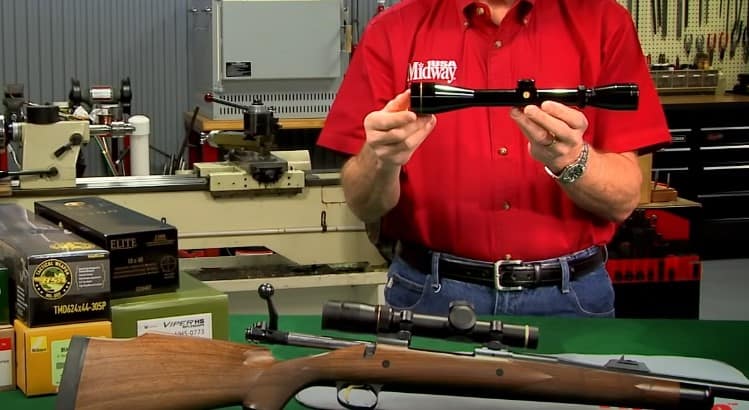Understanding Rifle Scope Turrets The Easy Way

Turrets are a critical component of the rifle scope. If you’ve never seen a scope, they are the little knobs on the top and, most commonly, the left-hand side of the scope.
Occasionally you have three turrets, but two turrets are universal. The overall job of a turret is to make the adjustments necessary to zero an optic.
Zeroing an optic is the process in which you carefully aim the weapon in the most stable position possible and attempt to place the crosshair where the weapon is shooting rounds.
This involves using both your turrets to carefully move the crosshair up, down, left, and right.
What Turrets On Your Rifle Scope Do?
Your most basic turret adjustments are referred to as windage and elevation.
1. Windage is your left and right adjustments, which is how the wind blows. Some turrets are designed to make instant adjustments for windage; other turrets are not designed for instant change.
2. The elevation is, of course, you’re up and down adjustments. These adjustments can also be made in the field for extremely far shots.
When shooting past certain ranges, your bullet will start to drop, and a scope can be zeroed for certain distances to perfectly compensate for bullet drop.
All bullets drop differently; even those of the same caliber can drop differently depending on bullet weight and load data.
3. The third adjustment that is occasionally seen is known as the parallax adjustment turret. Parallax is often a fixed feature of scope, but there has been a trend to make this an adjustable feature.
Parallax is basically how the target moves away from the reticle as you move your head. This creates an issue because it changes your point of aim, which can cause misses.
A fixed parallax of, say, 100 yards means at 100 yards and beyond your scope is parallax free. However, under 100 yards, you will experience parallax.
This will reduce your accuracy and cause point of aim and point of impact deviations. An adjustable parallax can reduce that parallax anywhere from 10 yards to infinity.
Different Types of Turrets
Turrets are not universal. Different scopes serve different purposes and have different turrets.
Turret type can be affected by not only the scope’s purpose, but the scope’s price, manufacturer, and even country of origin can have an effect on turrets. A brief overview of the types of turrets out is as follows.
Target Turrets
Target turrets are the most precise type of turret on the market. These turrets are also the oldest style turrets and gained their name from the target shooters who love them. They allow the shooter to make very small and precise adjustments.
They are most commonly available in MOA. They are characterized by their height and often small adjustment scales. Target turrets are poorly designed for the field because bumping and rubbing them can make unwanted adjustments.
Ballistic Turrets
Ballistic turrets are different than target turrets mainly by the fact they make larger adjustments. These are preferred by tactical shooters and hunters who need to hit a target fast and not make minuscule groupings at a designated range.
They are often capped to prevent any accidental adjustments. The adjustments for these turrets are commonly related to the distance you are firing in either yards or meters.
Fingertip
Fingertip or fingertip adjustable scopes are designed to make adjustments easy, with the turrets not requiring any tools. Fingertip turrets can be both target and ballistic turrets; they are not their own brand but an add-on feature.
Coin Style
Coin style turrets require a small tool to make adjustments. They gain the name coin style from the fact it’s the most commonly used tool. These turrets have small indentations that fit any variety of tools.
Milliradian Or Minute Of Angle
Milliradian and minute of angle, commonly expressed as MOA and MIL, are two different systems of measurement. Both MIL and MOA are used to make adjustments with the turrets on a scope. So, some adjustments are in MOA, and others are MIL.
MOA is essentially a much smaller way to measure degrees. A complete circle is 360 degrees, and an MOA is 1/60th of a degree. This means there are 21,600 minutes of angle in a circle.
At a hundred yards, 1 MOA is almost exactly an inch (1.04 to be exact.) Minute of angle is important to understand when it comes to turrets because many scope adjustments are in MOA.
If your adjustments are in MOA, they are likely to be in 1/8th MOA for precision scopes, ¼ MOA for your standard scopes, and ½ MOA for red dot scopes.
What this means is that with each turn of the dial, you are adjusting the scope in fractions of an inch. Every 8 clicks on a 1/8th MOA adjustable scope is 1 MOA, which is an inch at 100 yards.
MIL is a military favorite adjustment, and it’s used on mortars, machine guns, and occasionally sniper rifle optics. MIL scopes are gaining popularity in the civilian market.
The reason being is that a MIL never changes regardless of the distance. A MIL is a MIL at 5 yards or 5 thousand yards. Like MOA scopes, MIL scopes are often divided into fractional portions of a MIL. Most are .1 of a MIL. So, ten clicks on your turret equal one mil, which is 3.6 inches at a hundred yards.
Which is Better?
Is MIL or MOA better? Well, that is a personal question. MOA is the classic standard for rifle scopes, so your selection of scopes will be larger.
MIL is gaining steam, though, and due to its consistency, it is an excellent option. There really isn’t a better option, and this is more of a preference issue.
Important To Know: Scope Adjustment Numbers
Scopes are capped at a certain level of windage and elevation adjustments. Eventually, you will run out of clicks trying to go in one direction too far. How many adjustments do you need?
Well, first off, where and how far away are you shooting? Someone shooting in windy and wide-open planes probably wants more adjustments to compensate for wind and distance.
Someone shooting at a square range doesn’t need as many adjustments, so they can settle for something smaller.
The Bottom Line
Long-range accuracy can be drastically improved with a solid understanding of rifle scope turrets. Turrets in rifle scopes are like translators. Bullet impact points are not changed by the turrets by themselves.
Shooters can use them to calculate the impact point of a bullet when their rifles are properly set up. The scope and bullet’s path are considered one when the reticle is adjusted up, down, and side to side.

